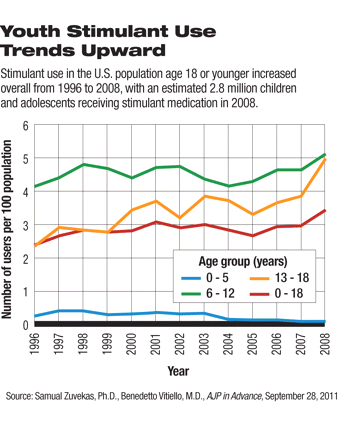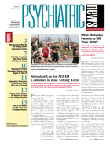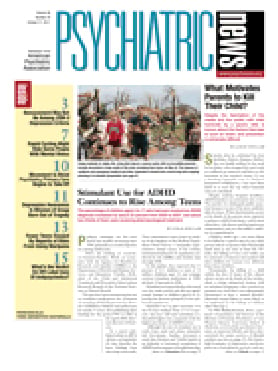Pediatric stimulant use has been slowly but steadily increasing since 1996, primarily as a result of greater use among adolescents.
That's the finding of researchers Samuel Zuvekas, Ph.D., an economist with the Agency for Healthcare Research and Quality (AHRQ) at the Department of Health and Human Services, and Benedetto Vitiello, M.D., chief of the Child and Adolescent Treatment and Preventive Intervention Research Branch of the National Institute of Mental Health.
The pair have been monitoring the use of stimulant medications for treatment of attention-deficit/hyperactivity disorder (ADHD) in children and adolescents for nearly 15 years, first publishing their findings for the period 1997 to 2002 in the April 2006 American Journal of Psychiatry.
In a report published online in AJP in Advance on September 28, they describe the latest findings from their long-term study. Their information comes from an analysis of the database of the Medical Expenditure Panel Survey, a nationally representative annual survey of the civilian, noninstitutionalized U.S. population conducted by the AHRQ, and includes data through 2008.
In this update, they reported that 3.5 percent of U.S. children (a total of 2.8 million children) aged 18 and younger received stimulant medication in 2008, up from 2.9 percent in 1996.
Stimulant use in preschoolers decreased over the study period and did not significantly change in children aged 6 to 12, leaving the increase primarily in the adolescent population.
Stimulant use in girls increased over the 10 years studied, from 1.1 to 1.6 percent, but boys still used stimulants at a threefold higher rate, consistent with the higher prevalence of ADHD in boys.
Although the rate of stimulant use in youth from racial and ethnic minorities and low-income families increased—a trend that Zuvekas and Vitiello lauded as an indicator of increased recognition of ADHD and acceptance of its pharmacological treatment by the groups for whom disparities in mental health services have traditionally existed—it remained lower than the rate in non-Hispanic white children.
"The persistence of differences in use among racial and ethnic groups indicates that social and cultural factors continue to play a significant role in ADHD treatment utilization, with parents of Hispanic and African-American children less likely to report ADHD than parents of white children," they said in their report. They pointed out that these race- and ethnicity-related differences are not accounted for by health or socioeconomic variables such as birth weight, income, or insurance coverage.
One geographic difference was noted, that of lower use of stimulant medications in children in the western regions of the United States, a trend not evident for pediatric use of other psychiatric medications, such as antidepressants.
A final trend identified by Zuvekas and Vitiello was the decline in the use of stimulants in the youngest age group of children, the preschoolers. They theorized that this drop may be due to concerns raised about use of stimulants in young children in 2000, followed by the publication of a controlled clinical trial that showed methylphenidate is effective in preschoolers with ADHD but also causes more adverse effects in this group than in school-aged children.
The authors reported no commercial funding for the study.


